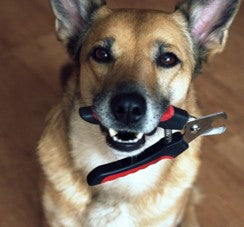An important part of any dog’s grooming is to take care of their nails. Long nails, not only are unsightly, can also present potential health problems. A dog’s nail is very strong and tends to grow at a slight downward angle. Nails which are left unattended may grow long enough to cause the entire tendon and bone structure of the foot and posture to weaken. In some severe cases, the nail can even grow so long as to curl back into the foot pad, which is extremely painful and prone to infection.
The nails should be trimmed back as a far as possible without causing excessive bleeding. This can be done every four to six weeks depending the dog breed and their lifestyle. Dogs who are active and do a lot of running / walking on hard surfaces tend to naturally wear down their nails. Dogs that are less active will need more nail trimming either by their owners or professional dog groomers to maintain a healthy nail length.
If the nails are only “tipped”, the quick (vein) will continue to grow further out along with the nail, making it harder to maintain a healthy short nail. These types of nails will require more frequent clipping in order to push the quick back towards its root and thus allowing more of the nail to be taken off over a period.
Trimming of white nails is easy as one can see the pink of the quick. One can then place the clipper at the point where the pink stops, commit to the spot and quickly make the cut. Black nails are more challenging, because the quick is not visible from the outside. One will then need to clip just the tip of the nail off (called the hook). Now one can observe the nail, there will be a black dark circle in the middle of the nail bed, that is the blood vessel but not the part that bleeds. One can keep taking little bits off at a time until a small white dot appears at the centre – this is as far as you can go before you clip the quick and cause bleeding. Once a length is established, use that nail as a guide for trimming the rest of the nails.
On many dogs, the rear nails are shorter than the front as they are used for power and drive – they push off with their back legs thereby wearing them down further. If one, does clip the quick, one can use quick stop (available at most veterinary practices) or corn starch/ flour. Apply directly onto the quick and apply firm pressure for a minimum of 30 seconds. Nail clipping should ideally be done before bathing, during the pre-work stage.
Some dogs can be indifferent to having their nails clipped while others dislike it with a passion. If unfamiliar with the dog, always start with the rear foot, allowing you to watch the dog for a reaction. If no reaction, continue clipping nail by nail. If a mild adverse reaction is noted, continue with caution but remain calm with an authoritative nature. Always keep the posture of the leg as close to the dog as possible, most times if you pull the leg outwards the instinct of the dog is to pull it back. If the reaction is severe, signs of growling and biting, then make use of a muzzle but remain calm. Always make use of positive praise, a happy / warm tone of voice and rewards such as small meat or biscuit treats make the process a lot of easier.
For more advice, speak to your grooming parlour for advice and a lesson on nail clipping. Professional groomers will also offer the service of nail clipping only, if you are on the wary side to try it yourself or if your dog can be intimidated by the process.

